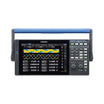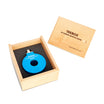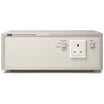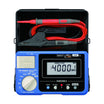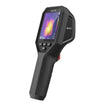
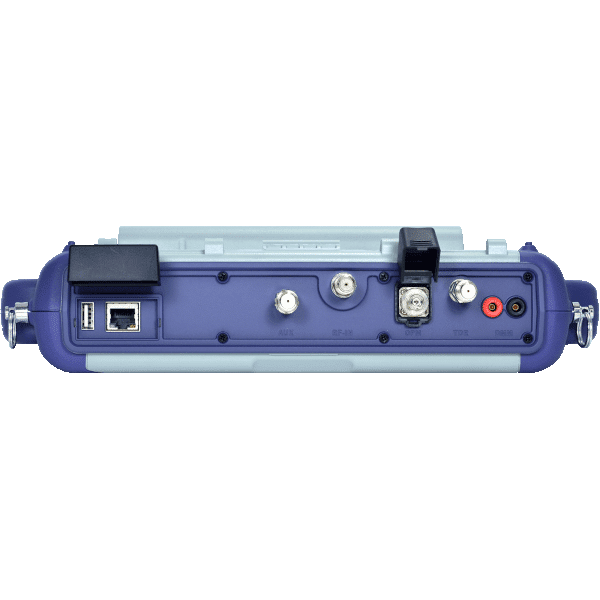
VeEX CX380C Advanced Plant Maintenance
Use our chat for personal support or contact us via +45 31 33 18 19 or salg@GOmeasure.dk
The VePAL CX380s-D3.1 is a next generation test solution designed for analog and digital cable TV networks with key maintenance tools including enhanced Spectrum Analysis with 1.8 GHz range, DOCSIS 3.1 OFDM Analysis, Digital Channel, Sweep, MPEG Analysis, and 10 Gigabit Ethernet test capabilities.
Discover the possibilities
More information
Description
VeEX CX380C Advanced Plant Maintenance
The VeEX CX380C features fast 1.8 GHz Spectrum Analysis and Sweep, DOCSIS 3.1 OFDM, Full SLM, V-Test Speedtest, OPM and TDR/DMM.Single Channel Measurement
Analog and digital carriers are very different in terms of signal content and power distribution and thus require the advanced SLM techniques supported in the CX380C. In analog mode, video and audio levels, V/A, Adjacent Channel, C/N, and HUM are measured.In digital mode, average power, MER, Pre-BER, Post-BER, Error seconds and constellation diagram are displayed. User programmable location thresholds and test point compensation are useful utilities enabling fast, simple and automated testing of carrier signals.'
Advanced Digital Channel Analysis
Digital pictures do not show signal impairment until it is too late because the margin between acceptable quality and failure is quite small.Constellation Diagrams
A valuable tool to help detect the presence of noise, phase jitter, interference, gain compression, laser clipping and ingress, all of which impact overall signal quality and thus reduces Modulation Error Ratio (MER).Adaptive Equalization
The built-in equalizer does a great job of improving MER of a QAM signal, but it is also important for technicians to know how hard the system is working to ensure adequate margin for system degradation. The active equalizer taps are displayed graphically providing an insightful view of which taps are working harder to overcome impairments. Frequency Response and Group Delay provides powerful diagnostic capability.Poor frequency response and group delay affect QAM signal integrity. Typical culprits are marginally balanced amplifiers. The equalizer can also be turned off to enable further troubleshooting of marginal amplifiers.
True Spectrum Analyzer
The CX380C offers a fast and powerful Spectrum Analyzer that incorporates advanced technology to capture transient ingress across a wide frequency range with 70 dB display range. Adjustable RBW, Signal Type, and Sweep settings optimize signal representation and noise floor performance.The frequency range is 5 MHz to 1.8 GHz, fully supporting the DOCSIS 3.1/4.0 specification. The large 7” high resolution TFT LCD features a fast refresh rate, preserving and displaying the finest spectrum details. Touch-screen control allows rapid on-the-fly changing of test parameters and simplifies measurements while horizontal and vertical markers and min/max hold displays signal values instantly and varying signal parameters over time.
Test profiles consisting of user-settable parameters such as CF, Span, RBW, and Marker positions can be saved and recalled for repeated testing. Waveform storage enables a user to compare and contrast a captured signal versus a current measurement, in both superimposed or split screen views.
Laser Clipping
Ingress and impulse noise can cause signal clipping when upstream fiber amplifier inputs are presented with excessive power levels. As more carriers are added to the return path using channel bonding, composite power to the laser will increase.Common Path Intermodulation Distortion (CPID/CPIM)
Spurious signals appearing in the upstream composed of distortion products of the downstream signals. Lower frequency components are passed through the diplex filter and amplified by the return amplifier. Common Path Distortions are intermittent by nature and are directly related to poor connections, corrosion, kinks and radial cracks in the cable.
Upstream Ingress
The return path is more susceptible to RF impairments because this frequency spectrum is heavily used for Ham and Citizen Band radio transmissions. Interference is not only limited to RF transmissions; Impulse noise generated by electric motors, switches, lightning strikes, high voltage power lines, vehicle ignitions, or household electrical appliances at the subscriber premise are particularly damaging to data transmissions where short bursts of interference can seriously reduce data throughput.The return path is also very vulnerable to a phenomenon known as Noise funneling. The summation of all unwanted noise (Gaussian, ingress and impulse noise) coming from both subscribers and the cable plant itself affects the return transmission system and needs to be monitored.
PLATFORM HIGHLIGHTS |
KEY FEATURES |
|
|
For more information: VeEX
Click here for related products: CATV Analyzers
Specifications
Documents
Options
Video
VeEX CX380C Advanced Plant Maintenance
The VeEX CX380C features fast 1.8 GHz Spectrum Analysis and Sweep, DOCSIS 3.1 OFDM, Full SLM, V-Test Speedtest, OPM and TDR/DMM.Single Channel Measurement
Analog and digital carriers are very different in terms of signal content and power distribution and thus require the advanced SLM techniques supported in the CX380C. In analog mode, video and audio levels, V/A, Adjacent Channel, C/N, and HUM are measured.In digital mode, average power, MER, Pre-BER, Post-BER, Error seconds and constellation diagram are displayed. User programmable location thresholds and test point compensation are useful utilities enabling fast, simple and automated testing of carrier signals.'
Advanced Digital Channel Analysis
Digital pictures do not show signal impairment until it is too late because the margin between acceptable quality and failure is quite small.Constellation Diagrams
A valuable tool to help detect the presence of noise, phase jitter, interference, gain compression, laser clipping and ingress, all of which impact overall signal quality and thus reduces Modulation Error Ratio (MER).Adaptive Equalization
The built-in equalizer does a great job of improving MER of a QAM signal, but it is also important for technicians to know how hard the system is working to ensure adequate margin for system degradation. The active equalizer taps are displayed graphically providing an insightful view of which taps are working harder to overcome impairments. Frequency Response and Group Delay provides powerful diagnostic capability.Poor frequency response and group delay affect QAM signal integrity. Typical culprits are marginally balanced amplifiers. The equalizer can also be turned off to enable further troubleshooting of marginal amplifiers.
True Spectrum Analyzer
The CX380C offers a fast and powerful Spectrum Analyzer that incorporates advanced technology to capture transient ingress across a wide frequency range with 70 dB display range. Adjustable RBW, Signal Type, and Sweep settings optimize signal representation and noise floor performance.The frequency range is 5 MHz to 1.8 GHz, fully supporting the DOCSIS 3.1/4.0 specification. The large 7” high resolution TFT LCD features a fast refresh rate, preserving and displaying the finest spectrum details. Touch-screen control allows rapid on-the-fly changing of test parameters and simplifies measurements while horizontal and vertical markers and min/max hold displays signal values instantly and varying signal parameters over time.
Test profiles consisting of user-settable parameters such as CF, Span, RBW, and Marker positions can be saved and recalled for repeated testing. Waveform storage enables a user to compare and contrast a captured signal versus a current measurement, in both superimposed or split screen views.
Laser Clipping
Ingress and impulse noise can cause signal clipping when upstream fiber amplifier inputs are presented with excessive power levels. As more carriers are added to the return path using channel bonding, composite power to the laser will increase.Common Path Intermodulation Distortion (CPID/CPIM)
Spurious signals appearing in the upstream composed of distortion products of the downstream signals. Lower frequency components are passed through the diplex filter and amplified by the return amplifier. Common Path Distortions are intermittent by nature and are directly related to poor connections, corrosion, kinks and radial cracks in the cable.
Upstream Ingress
The return path is more susceptible to RF impairments because this frequency spectrum is heavily used for Ham and Citizen Band radio transmissions. Interference is not only limited to RF transmissions; Impulse noise generated by electric motors, switches, lightning strikes, high voltage power lines, vehicle ignitions, or household electrical appliances at the subscriber premise are particularly damaging to data transmissions where short bursts of interference can seriously reduce data throughput.The return path is also very vulnerable to a phenomenon known as Noise funneling. The summation of all unwanted noise (Gaussian, ingress and impulse noise) coming from both subscribers and the cable plant itself affects the return transmission system and needs to be monitored.
PLATFORM HIGHLIGHTS |
KEY FEATURES |
|
|
For more information: VeEX
Click here for related products: CATV Analyzers


